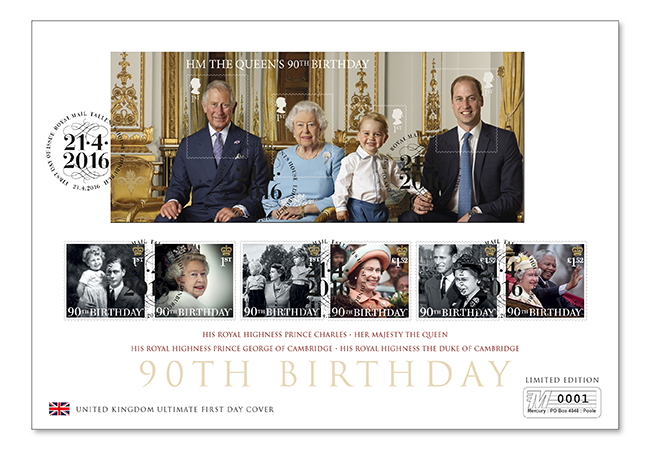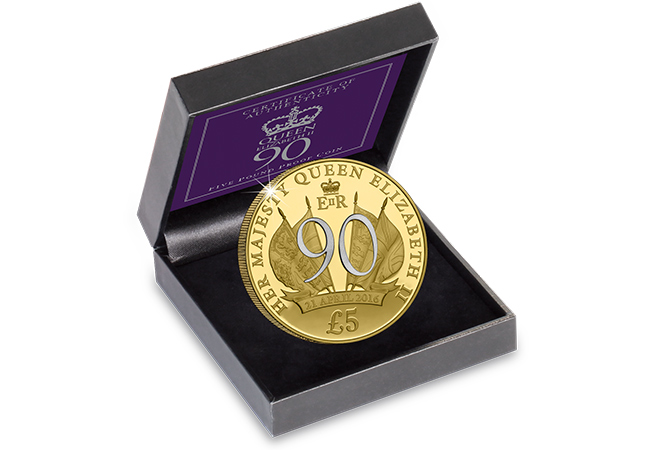Royalty
Prince George to appear on a British Stamp for the first time
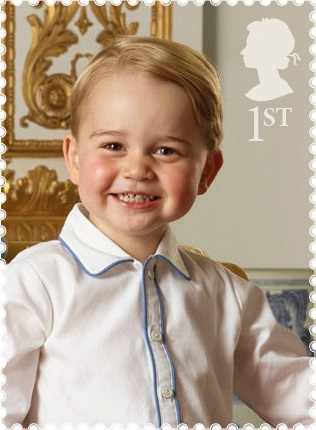 Prince George appears on a British 1st class stamp issued 21st April 2016 – the first time he will be pictured on our post.
Prince George appears on a British 1st class stamp issued 21st April 2016 – the first time he will be pictured on our post.
The new stamp is part of a special miniature sheet issued to commemorate the Queen’s 90th Birthday, and forms part of a group shot featuring Princes William and Charles, alongside Her Majesty the Queen herself.
Photographer Ranald Mackechnie captured the shot in Buckingham Palace’s White Drawing Room, with the aid of a few carefully positioned books to bring the young Prince George into the frame.
The miniature sheet harks back to the stamps issued in 2000 for the Queen Mother’s 100th birthday, which also featured a family scene. However this stamp sheet is particularly special, as it is the first time three heirs apparent have posed together in this way.
Perfect for collecting
The new stamp sheet will be particularly sought-after by collectors, as philatelic ‘firsts’ like this are always in demand – especially when linked to such an important Royal event.
Further adding to the appeal are six more commemorative UK stamps due to be issued simultaneously. Each features a photograph of the Queen from throughout her life, and the images are instantly evocative of her lifetime of service to the country.
Aside from their visual appeal, there are also a number of British ‘firsts’ here too, including the first time the Queen has been pictured on a stamp with a head of state from another country – in this case Nelson Mandela.
Suffice to say, this impressive new issue is a fitting tribute to The Queen, and these stamps will make a proud addition to the collection of anyone that wants to mark this landmark Royal occasion.
You can own ALL six new stamps, plus the miniature sheet, on The Ultimate Queen’s 90th Birthday First Day Cover. Officially postmarked by Royal Mail on the Queen’s Birthday 21st April 2016, this cover is available to order now.
SIX Remarkable Commemoratives that Celebrate Her Majesty’s 90th Birthday
This year Her Majesty Queen Elizabeth II becomes the first ever British monarch to celebrate her 90th birthday. This significant moment in history will certainly be one to remember.
So I’ve compiled a list of my six favourite commemoratives for you to peruse. In my opinion any Royal collector would be lucky to have these in their collection, especially the 10 ounce gold coin!
1. The Queen Elizabeth II 90th Birthday Proof Coin

This golden-coloured coin features a one-year only specially commissioned 90th birthday portrait, designed by Luigi Badia.
The coin proudly displays the royal cypher atop a large “90”. The central design is flanked by the Royal Standard and Union Flags on either side.
2. Guernsey 2016 Queen Elizabeth II’s 90th Birthday Silver £5 Proof Coin
 Featuring an oak wreath and crown to symbolise long life and the House of Windsor, this Silver £5 coin also features the limited edition one-year-only portrait.
Featuring an oak wreath and crown to symbolise long life and the House of Windsor, this Silver £5 coin also features the limited edition one-year-only portrait.
At the center is EIIR, encircled by the words Her Majesty Queen Elizabeth II and the years 1926-2016.
3. Australia 90th Birthday 1oz Silver High Relief Coin
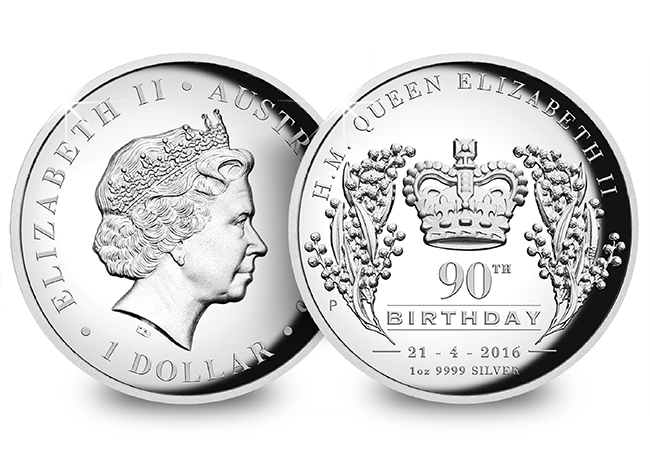 Issued by the Perth Mint, this stunning silver coin has been struck with an incredible high relief finish. To achieve this, each coin must be repeatedly struck on specially prepared presses.
Issued by the Perth Mint, this stunning silver coin has been struck with an incredible high relief finish. To achieve this, each coin must be repeatedly struck on specially prepared presses.
The reverse depicts St. Edwards crown surrounded by wattle branches – just 5,000 have been released worldwide.
4. The Queen Elizabeth II’s 90th Birthday Gold 10oz Coin
 Due to the significance of this Royal event, a remarkable 10 ounce gold coin has been issued. That’s the same weight as 33 pound coins!
Due to the significance of this Royal event, a remarkable 10 ounce gold coin has been issued. That’s the same weight as 33 pound coins!
Featuring the special one-year-only portrait, this 90th Birthday Coin was incredibly popular – in fact, it sold out its entire edition limit in a matter of hours.
5. QEII 90th Birthday Silver Coin Cover
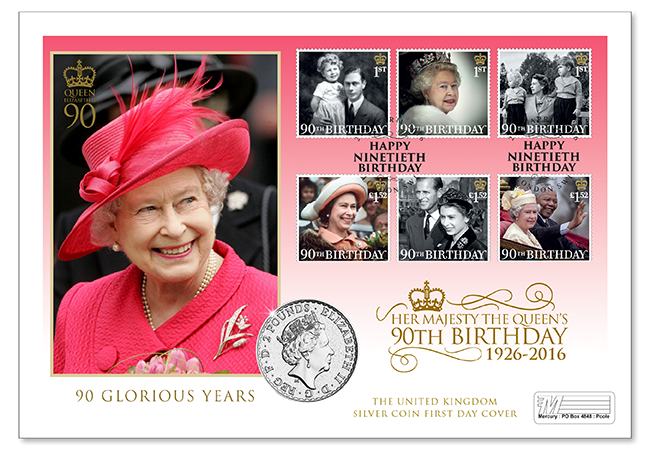 This limited edition Silver Coin Cover features the six UK stamps which have been issued by Royal Mail to mark the Queen’s 90th Birthday. All six evocative photographs feature on our stamps for the first time ever – including a rare picture of the young Princess with King George VI.
This limited edition Silver Coin Cover features the six UK stamps which have been issued by Royal Mail to mark the Queen’s 90th Birthday. All six evocative photographs feature on our stamps for the first time ever – including a rare picture of the young Princess with King George VI.
The new 2016 Silver Britannia coin is also encapsulated within the cover along with an official postmark by Royal Mail to mark the Queen’s birthday date – 21st April.
6. Queen Elizabeth II 90th Birthday Photographic Coin
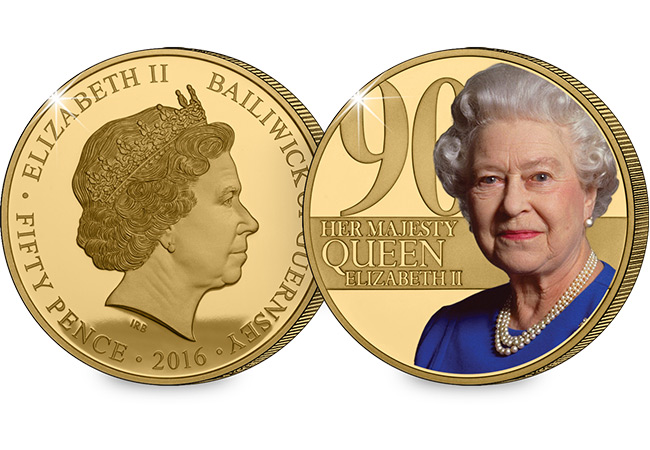 This is the first coin to be issued from The Queen’s 90th Birthday Coin Collection – a new series of photographic coins being issued over the coming months in celebration of the occasion.
This is the first coin to be issued from The Queen’s 90th Birthday Coin Collection – a new series of photographic coins being issued over the coming months in celebration of the occasion.
The coin has been expertly plated in 24 carat gold and features a full-colour birthday portrait – taken by renowned royal photographer Lord Snowdon for her 80th birthday.
This is a record-breaking moment in British history which will be remembered forever. And the coins and stamps which have been issued to mark the occasion really capture the moment.
Which of the six is your favourite commemorative? Let me know in the comments below.
You can add the Queen Elizabeth II 90th Birthday Proof Coin to your collection today
New coin issued to celebrate Queen Elizabeth II’s 90th Birthday

The Queen Elizabeth II 90th Birthday Proof £5 coin issued by Jersey
On 21st April, 2016, Her Majesty Queen Elizabeth II will celebrate her 90th birthday – the first British monarch ever to do so.
In honour of the occasion a new coin has been issued – featuring a specially commissioned one-year-only birthday portrait.
The coin has been officially approved by Her Majesty the Queen, and proudly displays the royal cypher atop a large “90”. The central design is flanked by the Royal Standard and Union Flags on either side.
But it is the new effigy that will fuel collector demand. Replacing the familiar standard portrait for one year only, renowned sculptor Luigi Badia was tasked with creating a special 90th Birthday engraving of the Queen.
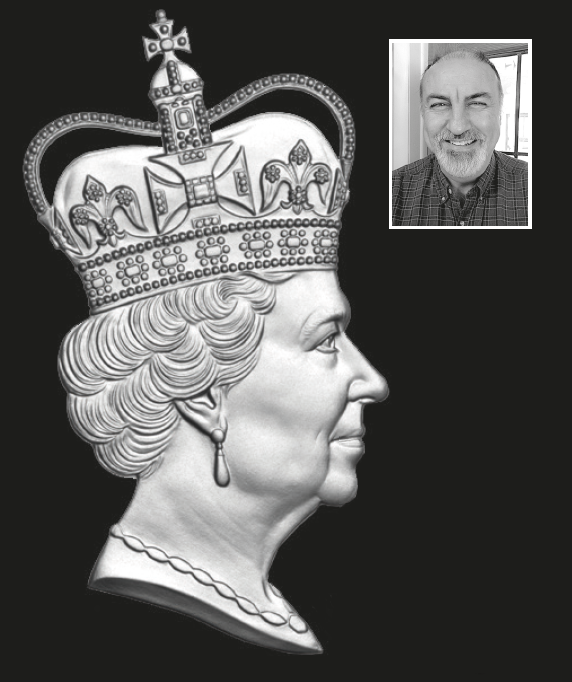
The specially commissioned 90th Birthday effigy by renowned sculptor Luigi Badia.
As you’ll appreciate, that is not a simple process, with an extremely rigorous approval procedure. To give you some idea, the Palace requested three separate revisions until they felt the effigy was perfect.
That’s why special portraits such as this are few and far between and are so popular with collectors.
Luigi, from New York, explains the concept behind the design:
“I was extremely honored to be commissioned to sculpt a brand new portrait to celebrate Her Majesty’s 90th birthday. I was inspired to use the St Edward’s crown as it captures her sense of duty from when she first wore it during her Coronation in 1953, a sense of duty that she has had through-out her life and reign”
The design process…

The design is intricately engraved onto the die
Careful consideration has to be put into the shape and size of the coin. Luigi painstakingly hand-engraved the design – with the added complication of retaining the typesetting within the circular shape.
The finalised ‘plaster’ engraving is then ready to be reduced down into a die (shown opposite) – which is hardened and used to mint the commemorative coins collectors can own.
Struck to a variety of specifications…
The new coin is to be struck in a range of different specifications, from a face value version right up to a staggering 10oz gold edition – which has already sold out.
And the other coins are likely to prove just as popular – with a highly collectable proof coin, a pure silver coin, and a 1/4oz gold coin amongst those available, there is something to suit everyone.
These coins really do make a fitting tribute to Her Majesty, and the stunning 90th birthday portrait marks them out as truly prestigious commemoratives to forever remember this once-in-a-lifetime celebration.
Special proof coin available now… 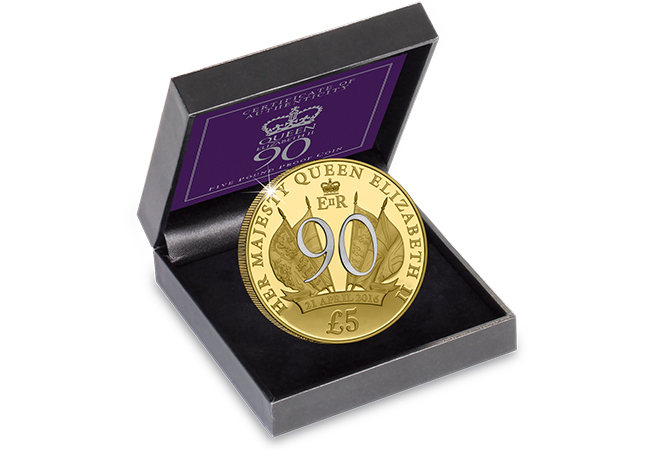
If you want to mark the occasion you can add a Queen Elizabeth II 90th Birthday Proof £5 Coin to your collection today.



